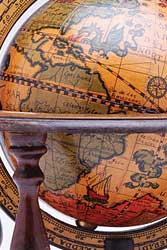
|
|
About Continuum Advertising Advisory Committee Archives Contact Us Continuum Home Faculty/Staff Subscribe related websites Alumni Association Marketing & Communications University of Utah Home |

A Global Tour of the UA sampling of other international programs and departments on campus.College of Social Work Middle East Center Asia Center Looking SouthThe U’s Latin American Studies program may be ready for the next step.Thanks to the hot-button issue of immigration reform, Latin America took center stage in 2006. In April, tens of thousands of Latinos rallied in the streets of Salt Lake City to call attention to immigrants’ rights. On May 1st, a nationwide “Day without Immigrants” initiative called on Latinos to stay home from work, school, and shopping in order to flex their cultural and economic muscle. And in late May, Mexican President Vicente Fox stood before the Utah Legislature and implored the U.S. and Mexico to work together on immigration solutions, firmly stating that a wall between the countries was not the answer. Education, on the other hand, just might be. The University of Utah’s Latin American Studies program is still in its infancy—just three and a half years old and currently only available as a minor—but work is afoot to expand and enhance the program. Professor Jim Lehning, interim director of the program, points to two factors that underscore the need for Latin American studies. First, he says, is the fact that immigration is not just from Mexico anymore. “The proportion of immigrants from Latin America who are from Mexico is decreasing,” says Lehning. “You’re seeing larger and larger proportions from Argentina, Chile, Venezuela, Ecuador, and Peru.” Second is the expansion of immigration to areas outside of traditional states like Arizona and New Mexico. “If you think in terms of the Intermountain area,” says Lehning, “immigrants from Latin America are having more and more of a presence farther north. If you project another 30 or 40 years, it’s going to be even more significant, and even farther north.” With that in mind, Lehning sees the need for the U to step into the big leagues, with more faculty, more resources, and the creation of an academic major. “For Latin American Studies to develop in a way that will make it useful,” he says, “it is going to require a strong commitment from the University and from the State.” |

Beyond Borders:
|